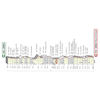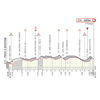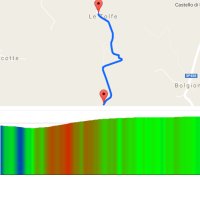With Strade Bianche the riders enter a race with medieval characteristics. In the rolling landscape of Tuscany the toughest sections are on twisting gravel paths.
Sector 1 comes inside the first 20 kilometres: 2.1 kilometres long and perfectly straight. A solid way to get warmed up to the hardships ahead.
The day’s first climb coincides with the second sector. It’s 5.8 kilometres on gravel and the steepest ramps are 10%. Following two flat to descending stretches of dirt road – respectively 4.4 and 5.5 kilometres – the Strade Bianche tackles its second climb. This one is on tarmac and leads to the fortified town of Montalcino.
After the downhill the route continues to Lucignano d’Asso, which is – at 11.9 kilometres – the longest sector. Not hard in itself, ‘sterrato 5’ is an enchanting stretch with fields and forest left and right. Just 1 kilometre of tarmac before the next gravel road brings something extra to the mix. At 8 kilometres, it runs on winding roads and includes both climbing and descending.
Some 11 kilometres of flat tarmac takes the riders to the next dust road. At 9.5 kilometers and mostly uphill, this one will weary the legs still further. It goes up and down in the first part and ends with a twisting climb before meeting the tarmac again.
At kilometre 130 the endgame begins with the presence of the Monte Sante Marie climb. Sector 8 amounts to 11.5 kilometres and is arguably the toughest of all sterrati at the Strade Bianche. It runs mostly uphill, although the strip also features some tricky descents.
Sector 8 continues onto 20 kilometres of smooth asphalt. Which may sound better than it actually is, as the route is either going up or down, while heading to the last three unpaved sectors.
Sterrato 9 is 800 metres long and pepped up with a double digit gradient ramp before hitting the tarmac in Vico d’Arbia. A rolling stretch continues onto the penultimate sterrato. Strade di Colle Pinzuto is 2.4 kilometres long and the steepest ramp is located at the beginning. But no time for a breather after this 15% ramp, as the road keeps climbing gradually all the way until the end.
The final gravel road is a 1.1 kilometres toil, opening with a short descent and closing with 18% gradients. When Strade Bianche reaches Le Tolfe there are still 12 kilometres to go. If any attackers are adrift, the winding roads of Tuscany favour them, as chasers will have difficulty pinpointing the attackers.
With 5 kilometres remaining the road flies downhill, only to go back up again in the last kilometre. Entering the city walls of Siena, a 16% sector welcomes the riders. Then a sharp turn to the right, left, and right again. The finish is at Il Campo, Siena’s iconic square resembling a theatre.
The route is a carbon copy of 2018 and 2019. Two years ago, the Strade Bianche was played out in pouring rain, which caused winner Tiesj Benoot to cross the line wearing a yellow-brownish mud mask. Last year’s race was won by Julian Alaphilippe in springlike conditions. The Frenchman outgunned Jakob Fuglsang in the steep finale in Siena.
Another interesting read: route Strade Bianche 2020.
Strade Bianche 2020: route, profiles, more
Click on the images to zoom










